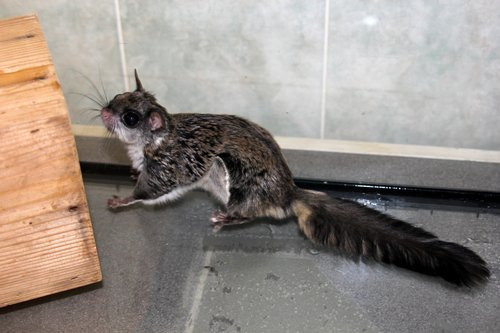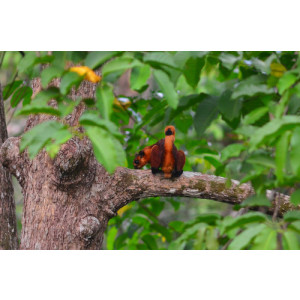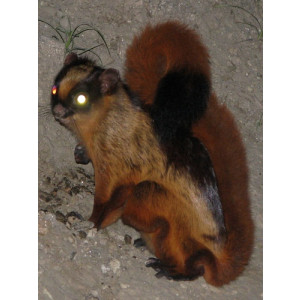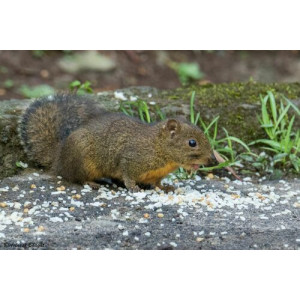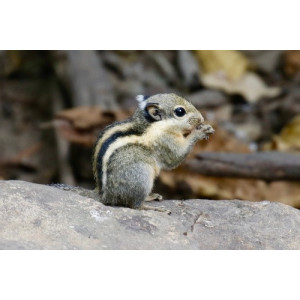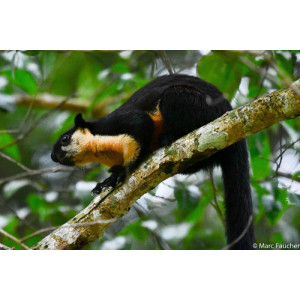Particolored Flying Squirrel Did you see this animal?
Scientific Name : Hylopetes alboniger
Family : Sciuridae
Order : Rodentia
Class : Mammalia
Phylum : Chordata
Habitat : Forest, Shrubland
Description : The Particolored Flying Squirrel is a relatively large species, measuring up to 60 cm in length including their tail. They have soft, dense fur that is usually a dark reddish-brown on their back and white or pale cream on their belly. They are called "flying squirrels" because of their ability to glide through the air. They have flaps of skin called patagia that extend from their wrists to their ankles and allow them to glide from tree to tree.
These squirrels are nocturnal and arboreal, meaning they are active at night and spend most of their time in trees. They are able to glide for distances of up to 150 meters between trees, using their patagia to control their direction and speed.
Particolored Flying Squirrels are herbivores and their diet consists mostly of fruits, nuts, and seeds. They are important seed dispersers, helping to maintain the health and diversity of forest ecosystems.
During the breeding season, males will compete for access to females. After mating, females will give birth to 1-2 offspring at a time, which they raise in nests made of leaves and twigs in the hollows of trees.
Particolored Flying Squirrels are threatened by habitat loss and degradation due to deforestation and human development. They are also hunted for their meat and fur in some parts of their range. Conservation efforts are needed to protect these unique and important species and their habitats.
In summary, the Particolored Flying Squirrel is a fascinating and unique species that is known for its ability to glide through the air. They play an important role in seed dispersal and maintaining the health and diversity of forest ecosystems. However, their populations are threatened by habitat loss and degradation, highlighting the need for conservation efforts to protect these important species and their habitats.
These squirrels are nocturnal and arboreal, meaning they are active at night and spend most of their time in trees. They are able to glide for distances of up to 150 meters between trees, using their patagia to control their direction and speed.
Particolored Flying Squirrels are herbivores and their diet consists mostly of fruits, nuts, and seeds. They are important seed dispersers, helping to maintain the health and diversity of forest ecosystems.
During the breeding season, males will compete for access to females. After mating, females will give birth to 1-2 offspring at a time, which they raise in nests made of leaves and twigs in the hollows of trees.
Particolored Flying Squirrels are threatened by habitat loss and degradation due to deforestation and human development. They are also hunted for their meat and fur in some parts of their range. Conservation efforts are needed to protect these unique and important species and their habitats.
In summary, the Particolored Flying Squirrel is a fascinating and unique species that is known for its ability to glide through the air. They play an important role in seed dispersal and maintaining the health and diversity of forest ecosystems. However, their populations are threatened by habitat loss and degradation, highlighting the need for conservation efforts to protect these important species and their habitats.
Distribution in Bangladesh
References:
description written by:Asad U. Tanvir,Department of Zoology,Jagannath University,Dhaka; reviewed by:Muntasir Akash,Department of Zoology,University of Dhaka;Taxonomic Checklist:Red List of Bangladesh Volume 2: Mammals, 2015, IUCN; information sources:indianbiodiversity.org; photo credit:Md Shalauddin (Jagannath University,Dhaka), photo copyright: iNaturalist.more information please contact with us.
description written by:Asad U. Tanvir,Department of Zoology,Jagannath University,Dhaka; reviewed by:Muntasir Akash,Department of Zoology,University of Dhaka;Taxonomic Checklist:Red List of Bangladesh Volume 2: Mammals, 2015, IUCN; information sources:indianbiodiversity.org; photo credit:Md Shalauddin (Jagannath University,Dhaka), photo copyright: iNaturalist.more information please contact with us.
